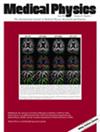A practical approach to the spatial-domain calculation of nonprewhitening model observers in computed tomography
Abstract
Background
Modern reconstruction algorithms for computed tomography (CT) can exhibit nonlinear properties, including non-stationarity of noise and contrast dependence of both noise and spatial resolution. Model observers have been recommended as a tool for the task-based assessment of image quality (Samei E et al., Med Phys. 2019; 46(11): e735-e756), but the common Fourier domain approach to their calculation assumes quasi-stationarity.
Purpose
A practical spatial-domain approach is proposed for the calculation of the nonprewhitening (NPW) family of model observers in CT, avoiding the disadvantages of the Fourier domain. The methodology avoids explicit estimation of a noise covariance matrix. A formula is also provided for the uncertainty on estimates of detectability index, for a given number of slices and repeat scans. The purpose of this work is to demonstrate the method and provide comparisons to the conventional Fourier approach for both iterative reconstruction (IR) and a deep Learning-based reconstruction (DLR) algorithm.
Materials and methods
Acquisitions were made on a Revolution CT scanner (GE Healthcare, Waukesha, Wisconsin, USA) and reconstructed using the vendor's IR and DLR algorithms (ASiR-V and TrueFidelity). Several reconstruction kernels were investigated (Standard, Lung, and Bone for IR and Standard for DLR). An in-house developed phantom with two flat contrast levels (2 and 8 mgI/mL) and varying feature size (1–10 mm diameter) was used. Two single-energy protocols (80 and 120 kV) were investigated with two dose levels (CTDIvol = 5 and 13 mGy).
The spatial domain calculations relied on repeated scanning, region-of-interest placement and simple operations with image matrices. No more repeat scans were utilized than required for Fourier domain estimations. Fourier domain calculations were made using techniques described in a previous publication (Thor D et al., Med Phys. 2023;50(5):2775-2786). Differences between the calculations in the two domains were assessed using the normalized root-mean-square discrepancy (NMRSD).
Results
Fourier domain calculations agreed closely with those in the spatial domain for all zero-strength IR reconstructions, which most closely resemble traditional filtered backprojection. The Fourier-based calculations, however, displayed higher detectability compared to those in the spatial domain for IR with strong iterative strength and for the DLR algorithm. The NRMSD remained within 10% for the NPW model observer without eye filter, but reached larger values when an eye filter was included. The formula for the uncertainty on the detectability index was validated by bootstrap estimates.
Conclusion
A practical methodology was demonstrated for calculating NPW observers in the spatial domain. In addition to being a valuable tool for verifying the applicability of typical Fourier-based methodologies, it lends itself to routine calculations for features embedded in a phantom. Higher estimates of detectability were observed when adopting the Fourier domain methodology for IR and for a DLR algorithm, demonstrating that use of the Fourier domain can indicate greater benefit to noise suppression than suggested by spatial domain calculations. This is consistent with the results of previous authors for the Fourier domain, who have compared to human and other model observers, but not, as in this study, to the NPW model observer calculated in the spatial domain.


 求助内容:
求助内容: 应助结果提醒方式:
应助结果提醒方式:


